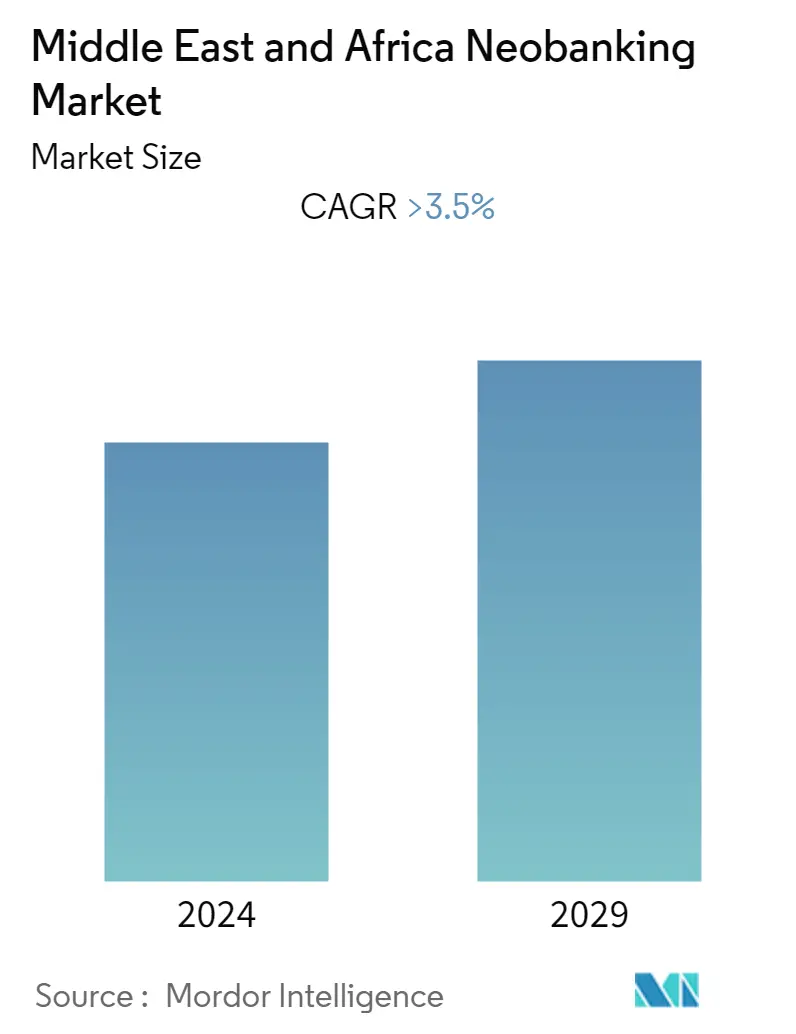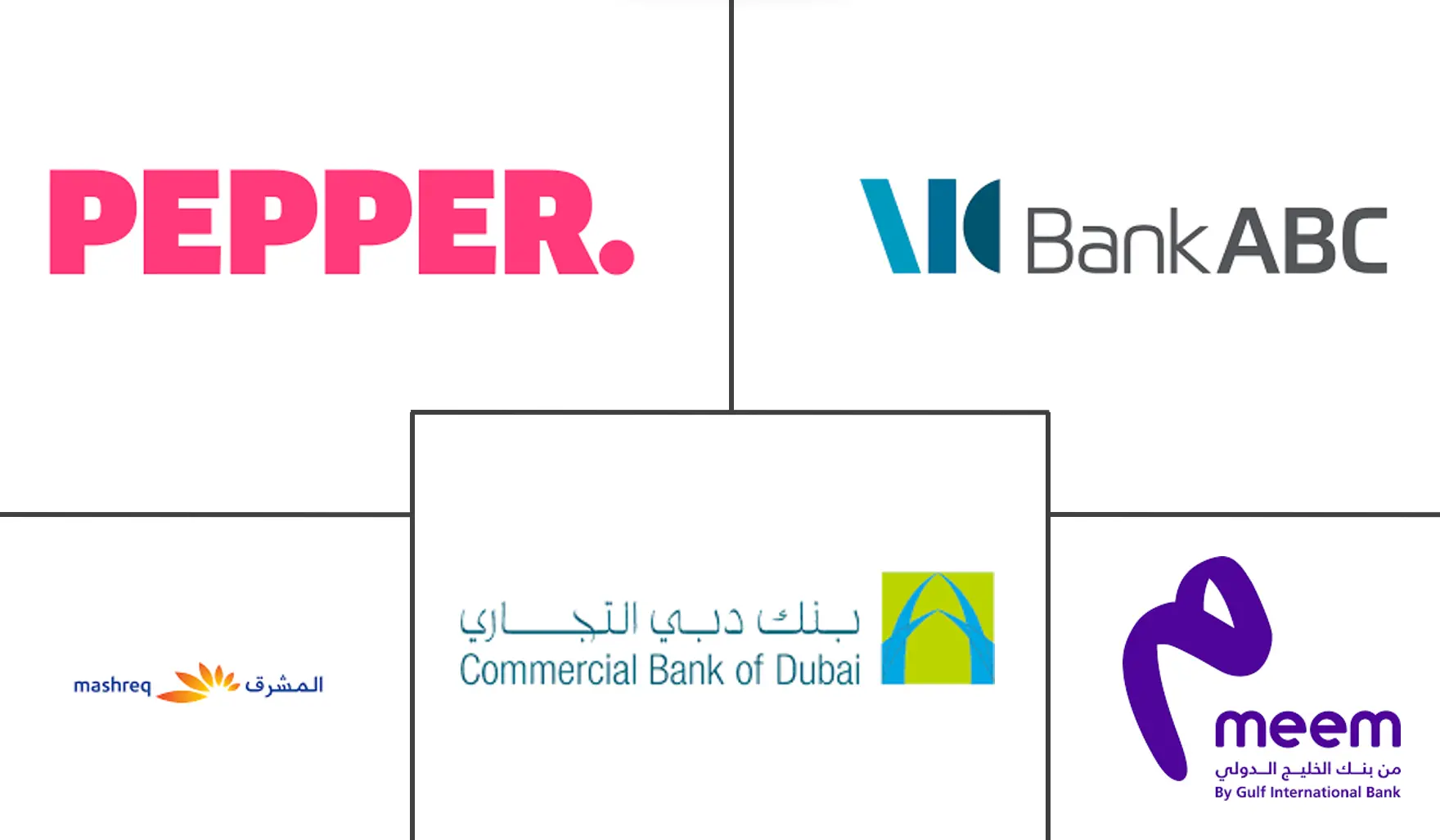Market Size of Middle East and Africa Neobanking Industry

| Study Period | 2020 - 2029 |
| Base Year For Estimation | 2023 |
| Forecast Data Period | 2024 - 2029 |
| Historical Data Period | 2020 - 2022 |
| CAGR | 3.50 % |
| Market Concentration | Medium |
Major Players
*Disclaimer: Major Players sorted in no particular order |
Middle East and Africa Neobanking Market Analysis
A neobank is a digital bank that does not have any branches. Instead of having a physical presence at a set location, neobanking is entirely online. A broad collection of financial service providers, who primarily target tech-savvy customers, comes under the umbrella of neobanking. Neobanks are financial institutions that give customers a cheaper alternative to traditional banks. You could think of them as digital banks without any physical branches, offering services that traditional banks don't, and doing so efficiently. They leverage technology and artificial intelligence to offer personalised services to customers while minimising operating costs.
The Covid-19 crisis has further pushed banks to undergo digital transformations. Technology promises greater resiliency, innovation and opportunities alongside improved efficiency and customer service.
The Middle East and Africa is a blossoming region in fintech, especially when it comes to banking technologies. And as far as untapped potential goes, the Middle East and Africa region is perfectly poised to become the next bubbling hub of digital banking innovation. The UAE has become one of the fastest-growing economic and technological hubs, owing to the National Innovation Strategy.
Middle East and Africa Neobanking Industry Segmentation
Neobanks is a bank that operates online without having a physical presence, it is part of fintech that provides digital and mobile-first services like payments, debit cards, money transfers, lending, and more. Middle East and Africa Neobanking Market is segmented By Account type (Business Account and Savings Account), By Service (Mobile Banking, Payments & money transfer, Savings account, Loans, and Others), By Application (Enterprise, Personal, and Others), and By Country (Saudi Arabia, United Arab Emirates, South Africa, Bahrain, Oman, Qatar, and Others)
| By Account | |
| Business account | |
| Savings account |
| By Service | |
| Mobile Banking | |
| Payments & Money transfer | |
| Savings account | |
| Loans | |
| Others |
| By Application | |
| Enterprise | |
| Personal | |
| Others |
| Geography | |
| UAE | |
| Saudi Arabia | |
| United Arab Emirates | |
| Qatar | |
| South Africa | |
| Oman | |
| Israel | |
| Turkey | |
| Rest of the Middle East |
Middle East and Africa Neobanking Market Size Summary
The Middle East and Africa neobanking market is experiencing significant growth, driven by the region's burgeoning fintech landscape and the increasing demand for digital banking solutions. Neobanks, which operate exclusively online without physical branches, are gaining traction by offering cost-effective alternatives to traditional banking services. They leverage advanced technologies such as artificial intelligence, robotics process automation, and cloud analytics to provide personalized and secure banking experiences. This digital-only approach allows neobanks to minimize operational costs, enabling them to offer lower fees and higher interest rates on deposits. The Covid-19 pandemic has accelerated the shift towards digital transformation, prompting traditional banks to adopt more innovative and efficient solutions to meet customer expectations.
The neobanking sector in the Middle East and Africa is poised for further expansion, with major players like Bank ABC, CBD Now, Mashreq NEO, and Pepper leading the charge. These companies are capitalizing on the region's untapped potential by securing new contracts and exploring new markets. Partnerships, such as the one between Mastercard, One Global, and i2c, are enhancing the availability of digital payment solutions, while initiatives like Mashreq Bank's Neopay are consolidating payment systems to streamline services. The region's focus on innovation and technology, particularly in the UAE, positions it as a promising hub for digital banking advancements, offering seamless international payments and efficient loan processes with minimal paperwork.
Middle East and Africa Neobanking Market Size - Table of Contents
-
1. MARKET DYNAMICS
-
1.1 Market Overview
-
1.2 Market Drivers
-
1.3 Market Restraints
-
1.4 Insights on Various Regulatory Landscape
-
1.5 Porters 5 Force Analysis
-
1.5.1 Threat of New Entrants
-
1.5.2 Bargaining Power of Buyers/Consumers
-
1.5.3 Bargaining Power of Suppliers
-
1.5.4 Threat of Substitute Products
-
1.5.5 Intensity of Competitive Rivalry
-
-
1.6 Insights on impact of technology and innovation in the market
-
1.7 Impact of COVID-19 on the Industry
-
-
2. MARKET SEGMENTATION
-
2.1 By Account
-
2.1.1 Business account
-
2.1.2 Savings account
-
-
2.2 By Service
-
2.2.1 Mobile Banking
-
2.2.2 Payments & Money transfer
-
2.2.3 Savings account
-
2.2.4 Loans
-
2.2.5 Others
-
-
2.3 By Application
-
2.3.1 Enterprise
-
2.3.2 Personal
-
2.3.3 Others
-
-
2.4 Geography
-
2.4.1 UAE
-
2.4.2 Saudi Arabia
-
2.4.3 United Arab Emirates
-
2.4.4 Qatar
-
2.4.5 South Africa
-
2.4.6 Oman
-
2.4.7 Israel
-
2.4.8 Turkey
-
2.4.9 Rest of the Middle East
-
-
Middle East and Africa Neobanking Market Size FAQs
What is the current Middle East and Africa Neobanking Market size?
The Middle East and Africa Neobanking Market is projected to register a CAGR of greater than 3.5% during the forecast period (2024-2029)
Who are the key players in Middle East and Africa Neobanking Market?
Pepper, Bank ABC, CBD Now, Mashreq NEO and Meem are the major companies operating in the Middle East and Africa Neobanking Market.

